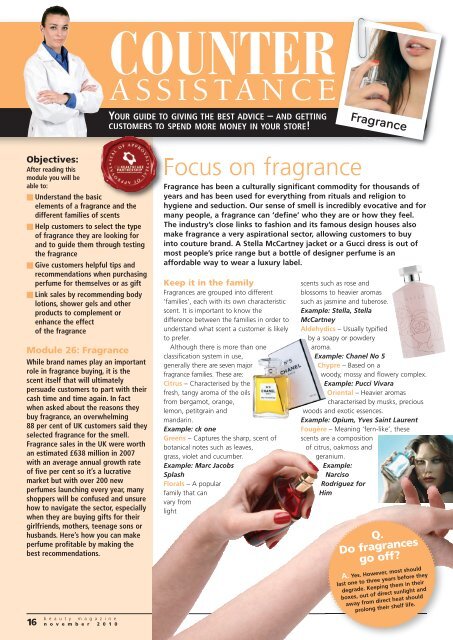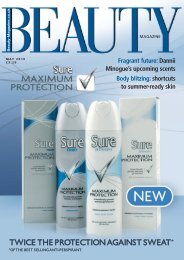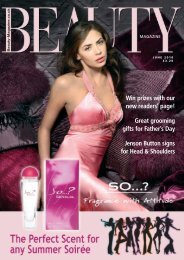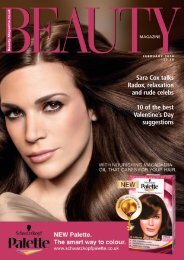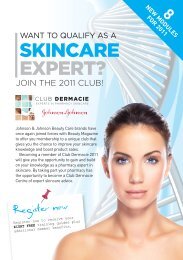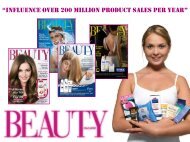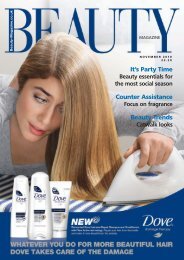Fragrance - Beauty Magazine
Fragrance - Beauty Magazine
Fragrance - Beauty Magazine
Create successful ePaper yourself
Turn your PDF publications into a flip-book with our unique Google optimized e-Paper software.
COUNTER<br />
A S S I S TA N C E<br />
YOUR GUIDE TO GIVING THE BEST ADVICE – AND GETTING<br />
CUSTOMERS TO SPEND MORE MONEY IN YOUR STORE!<br />
<strong>Fragrance</strong><br />
Objectives:<br />
After reading this<br />
module you will be<br />
able to:<br />
n Understand the basic<br />
elements of a fragrance and the<br />
different families of scents<br />
n Help customers to select the type<br />
of fragrance they are looking for<br />
and to guide them through testing<br />
the fragrance<br />
n Give customers helpful tips and<br />
recommendations when purchasing<br />
perfume for themselves or as gift<br />
n Link sales by recommending body<br />
lotions, shower gels and other<br />
products to complement or<br />
enhance the effect<br />
of the fragrance<br />
Module 26: <strong>Fragrance</strong><br />
While brand names play an important<br />
role in fragrance buying, it is the<br />
scent itself that will ultimately<br />
persuade customers to part with their<br />
cash time and time again. In fact<br />
when asked about the reasons they<br />
buy fragrance, an overwhelming<br />
88 per cent of UK customers said they<br />
selected fragrance for the smell.<br />
<strong>Fragrance</strong> sales in the UK were worth<br />
an estimated £638 million in 2007<br />
with an average annual growth rate<br />
of five per cent so it’s a lucrative<br />
market but with over 200 new<br />
perfumes launching every year, many<br />
shoppers will be confused and unsure<br />
how to navigate the sector, especially<br />
when they are buying gifts for their<br />
girlfriends, mothers, teenage sons or<br />
husbands. Here’s how you can make<br />
perfume profitable by making the<br />
best recommendations.<br />
16 b e a u t y m a g a z i n e<br />
n o v e m b e r 2 0 1 0<br />
Focus on fragrance<br />
<strong>Fragrance</strong> has been a culturally significant commodity for thousands of<br />
years and has been used for everything from rituals and religion to<br />
hygiene and seduction. Our sense of smell is incredibly evocative and for<br />
many people, a fragrance can ‘define’ who they are or how they feel.<br />
The industry’s close links to fashion and its famous design houses also<br />
make fragrance a very aspirational sector, allowing customers to buy<br />
into couture brand. A Stella McCartney jacket or a Gucci dress is out of<br />
most people’s price range but a bottle of designer perfume is an<br />
affordable way to wear a luxury label.<br />
Keep it in the family<br />
<strong>Fragrance</strong>s are grouped into different<br />
‘families’, each with its own characteristic<br />
scent. It is important to know the<br />
difference between the families in order to<br />
understand what scent a customer is likely<br />
to prefer.<br />
Although there is more than one<br />
classification system in use,<br />
generally there are seven major<br />
fragrance families. These are:<br />
Citrus – Characterised by the<br />
fresh, tangy aroma of the oils<br />
from bergamot, orange,<br />
lemon, petitgrain and<br />
mandarin.<br />
Example: ck one<br />
Greens – Captures the sharp, scent of<br />
botanical notes such as leaves,<br />
grass, violet and cucumber.<br />
Example: Marc Jacobs<br />
Splash<br />
Florals – A popular<br />
family that can<br />
vary from<br />
light<br />
scents such as rose and<br />
blossoms to heavier aromas<br />
such as jasmine and tuberose.<br />
Example: Stella, Stella<br />
McCartney<br />
Aldehydics – Usually typified<br />
by a soapy or powdery<br />
aroma.<br />
Example: Chanel No 5<br />
Chypre – Based on a<br />
woody, mossy and flowery complex.<br />
Example: Pucci Vivara<br />
Oriental – Heavier aromas<br />
characterised by musks, precious<br />
woods and exotic essences.<br />
Example: Opium, Yves Saint Laurent<br />
Fougère – Meaning ‘fern-like’, these<br />
scents are a composition<br />
of citrus, oakmoss and<br />
geranium.<br />
Example:<br />
Narciso<br />
Rodriguez for<br />
Him<br />
Q.<br />
Do fragrances<br />
go off?<br />
A. Yes. However, most should<br />
last one to three years before they<br />
degrade. Keeping them in their<br />
boxes, out of direct sunlight and<br />
away from direct heat should<br />
prolong their shelf life.
Each of these fragrance families can in<br />
turn be divided further into sub-sectors.<br />
Sub-groups include gourmand fragrances<br />
such as Thierry Mugler’s Angel which are<br />
characterised by sweet ‘edible’ accents like<br />
chocolate or marine fragrances and Aqua<br />
di Giò, which capture the<br />
freshness of water.<br />
It is likely that a customer<br />
will prefer scents from one or<br />
two of the fragrance families.<br />
Finding out which ones they<br />
like best will help you to<br />
recommend a new scent they<br />
might like.<br />
Concentrate!<br />
A ‘type’ of fragrance depends on the<br />
concentration of ‘jus’ or perfume oil<br />
within it. This affects how intense the<br />
fragrance is and how long it will last on<br />
the skin – as well as how expensive it is.<br />
These are the most commonly accepted<br />
concentration types:<br />
Perfume extract – Typically contains 20<br />
per cent aromatic compounds (though it<br />
can be as high as 40 per cent) and is the<br />
longest-lasting scent. It is the least volatile<br />
form of fragrance – around 50 per cent of<br />
the perfume will last for 24 hours.<br />
Eau de parfum – Typically<br />
contains 15 per cent aromatic<br />
compounds and is the second<br />
longest-lasting scent. It has<br />
been described as a<br />
‘suped-up’ eau de toilette –<br />
around 70 per cent will<br />
disappear in four hours.<br />
Eau de toilette – Typically<br />
contains 10 per cent<br />
aromatic compounds. Around 80 per<br />
cent of the fragrance will disappear<br />
in four hours – it’s made for<br />
refreshment but not formulated<br />
to last.<br />
Eau de Cologne – Typically<br />
contains 5 per cent aromatic<br />
TOP TIPS<br />
Application: Advise your customer to<br />
apply perfume to pulse points such as<br />
the folds in the crook of your elbow and<br />
back of knees, wrist, and neck and not<br />
to rub wrists together as this crushes<br />
the smell. Spraying a little into the air<br />
and walking into the perfume is also a<br />
good way to apply and helps to diffuse<br />
the scent over the body.<br />
compounds so very little stays on the skin;<br />
it is very volatile so it dissipates very<br />
quickly. Eau de Colognes are designed to<br />
refresh or act as a pick-me-up. People<br />
used to bathe in it as its alcohol solution is<br />
purifying.<br />
Splash / Eau Fraiche / After shave –<br />
Typically contain 1-3 per cent aromatic<br />
compounds. As above, they are designed<br />
to refresh rather<br />
than last.<br />
Limited editions<br />
Limited editions of established fragrances have become big business<br />
and most houses these days launch one-off scents for summer.<br />
Based closely on the original scent, limited editions will generally<br />
vary in one of the following ways:<br />
• Some limited edition perfumes keep exactly the same<br />
scent as the original, but they are packaged in new bottle<br />
designs, marking them out as different (Marc Jacobs Daisy<br />
Blooms in Spring comes in a customised bottle). In certain cases,<br />
these become collectors’ items.<br />
• Other limited edition fragrances boast a brand new scent, which<br />
is reminiscent of the original, but certain notes are tweaked or added<br />
to make it different. Often these scents will contain lighter, fresher<br />
notes for summer.<br />
It is important<br />
to note that different<br />
fragrance houses use<br />
different amounts of oils for<br />
each of their perfumes, so<br />
an EDT from one house<br />
could be ‘stronger’ than<br />
an EDP from another.<br />
M O D U L E<br />
26<br />
F R A G R A N C E<br />
Once you’ve read through this<br />
module, complete the multiple<br />
choice questions at the end to<br />
gain professional recognition<br />
and a certificate that can be<br />
kept as a CV highlight.<br />
Top tips for selling<br />
n Customers will want to try<br />
before they buy, so make sure<br />
testers are available<br />
n Have a stack of scent strips at<br />
the counter so shoppers can test<br />
fragrances without having to<br />
spray them onto their skin. This<br />
allows customers to try more –<br />
and avoid smelling of something<br />
they dislike all day<br />
n Recommend people do not try<br />
too many fragrances in one go.<br />
The nose will become ‘fatigued’<br />
after about six and will stop<br />
smelling as effectively<br />
n Once a customer has narrowed<br />
down their options, suggest they<br />
try a couple on their skin.<br />
<strong>Fragrance</strong>s smell different on<br />
different people (because of the<br />
oils in their skin, their hormones,<br />
their diet etc), so it’s important<br />
to see how it suits them<br />
n Recommend shoppers give a<br />
scent several minutes to ‘settle’<br />
before they decide on it. This<br />
gives the heart and base of the<br />
fragrance a chance to emerge<br />
and will give buyers a fuller<br />
impression of the scent<br />
n Lots of perfumes are bought<br />
on impulse, so use the marketing<br />
materials that accompany<br />
launches to make the fragrance<br />
area enticing. Many brands have<br />
celebrity faces and/or big budget<br />
adverts that can be used to catch<br />
a shopper’s eye.<br />
b e a u t y m a g a z i n e<br />
n o v e m b e r 2 0 1 0<br />
17
Get Thinking<br />
Think about the fragrances and related products<br />
available in your store and then decide how you<br />
might answer a customer who was looking for<br />
recommendations for:<br />
■ A birthday gift for a teenage boy<br />
■ A Valentine’s Day present for a woman in her 30’s<br />
■ A mother’s day gift<br />
■ An anniversary present for a man in his late 50’s<br />
■ A gift set to say thank you to a colleague at work<br />
BEAUTY<br />
Anna Smith<br />
Has successfullycompleted<strong>Beauty</strong><strong>Magazine</strong>’s<br />
training module on<br />
fragrance<br />
MAGAZINE<br />
COUNTER<br />
A S S I S TA N C E<br />
ACCREDITED TRAINING FOR IN-STORE BEAUTY EXPERTISE<br />
Awarded November 2010<br />
Katy Harrington,<br />
Lesley Johnson,<br />
BEAUTY <strong>Magazine</strong> Deputy Editor<br />
BSc MRPharmS, CIG Healthcare Partnership<br />
Take note!<br />
<strong>Fragrance</strong> is musically described as having<br />
three notes, which together make up a<br />
harmonious chord, or accord. These notes<br />
unfold over time as their ingredients<br />
evaporate and allow the perfume to<br />
develop or mellow.<br />
Top notes: Also called head notes, these<br />
comprise of smaller, lighter molecules that<br />
evaporate quickly – over five to 30<br />
minutes. Top notes are initially the most<br />
perceptible and are important as they<br />
provide the first impression of a fragrance.<br />
Middle notes: Also called heart notes,<br />
these form the main body of the scent<br />
and generally classify the fragrance family<br />
(e.g. floral, oriental). They emerge as the<br />
top notes evaporate, usually taking 10 to<br />
30 minutes to come to the fore.<br />
Bottom notes: Also called base notes,<br />
these additionally provide a key theme to<br />
the fragrance as they last the longest.<br />
Often not perceptible until 30 minutes<br />
after application, they would smell<br />
powerful, even unpleasant, alone, but<br />
mellow over time and as they blend with<br />
the other notes.<br />
Link Sales<br />
Advise customers to layer perfumes<br />
for a greater effect by using other<br />
perfumed products. Begin with<br />
shower or bath gel and then rub in<br />
body lotion or spray with a<br />
matching scent after bath<br />
spray. Finally apply the scent<br />
preferably as perfume or Eau de<br />
Parfum.<br />
Testing…Testing!<br />
Work through the Activity (below left) to test<br />
your knowledge of the fragrance sector.<br />
To gain recognition for your training in<br />
this area, complete the six multiple<br />
choice questions (below) online at<br />
www.<strong>Beauty</strong>-<strong>Magazine</strong>.co.uk/<strong>Fragrance</strong>.<br />
A certificate will automatically be generated<br />
for everyone who passes. These can be saved<br />
onto your PC and printed off for your files.<br />
In 2007 the UK fragrance industry was<br />
worth an estimated:<br />
a. £368 million<br />
b. £868 million<br />
c. £638 million<br />
d. £668 million<br />
2. The majority of UK consumers choose<br />
their fragrance based on:<br />
a. Celebrity endorsement<br />
b. Value for money<br />
c. Its smell<br />
d. The packaging<br />
3. Which of these generally contains the<br />
higest perecentage of aromatic compounds<br />
and is the second longest-lasting scent?<br />
a. Eau de Cologne<br />
b. After shave<br />
c. Eau de toilette<br />
d. Eau de parfum<br />
4. <strong>Fragrance</strong>s in the citrus family are<br />
characterised by:<br />
a. Woody, mossy scents<br />
b. Sharp, botanical notes<br />
c. Heavy, musky aromas<br />
d. Fresh, tangy aromas<br />
UK retail value sales of women’s fragrances, at current and constant prices, 2005 – 2015<br />
Source: Mintel<br />
Activity<br />
Take part in some in-store training by asking members of staff to take turns acting the<br />
customer. Ask them leading questions about the fragrance they are looking for…Is it a<br />
perfume for them? Or a gift for a friend or family member? What type of scents do they<br />
usually wear? Using the information suggest a few fragrances to try and see if your<br />
suggestions are well received.<br />
5. <strong>Fragrance</strong> lasts:<br />
a. About three months<br />
b. Between one to three years<br />
c. Forever, if you store it correctly<br />
d. Between six months and a year<br />
6. Bottom or base notes are perceptible:<br />
a. About 30 minutes after application<br />
b. About 10 minutes after application<br />
c. About an hour after application<br />
d. About three minutes after application.<br />
18 b e a u t y m a g a z i n e<br />
n o v e m b e r 2 0 1 0


